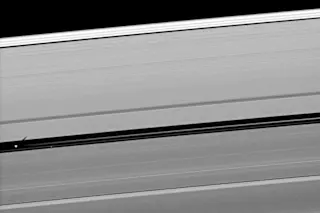Pan, one of the moons seen during Cassini’s close flybys, orbits in the Encke gap of Saturn’s rings. (Credit: NASA/JPL/Space Science Institute) NASA's Cassini mission to Saturn may have ended in 2017, but researchers are still analyzing the vast amount of data it sent back over its final spectacular months. Astronomers most recent findings, published Thursday, center on five of Saturn’s small ring moons: Pan, Daphnis, Atlas, Pandora and Epimetheus. During six close flybys near the end of its mission, Cassini uncovered new insights into how the moons formed, and what gives them their different colors. And astronomers say they now have strong evidence that these tiny moons formed from the dust of Saturn's rings. That's interesting because the rings themselves likely formed from shredded moons.
One of Saturn's small moons, Pan, is shaped like a walnut and stretches just 21 miles (35 kilometers) across. (Credit: NASA, Matúš Motlo)
Saturn ...














